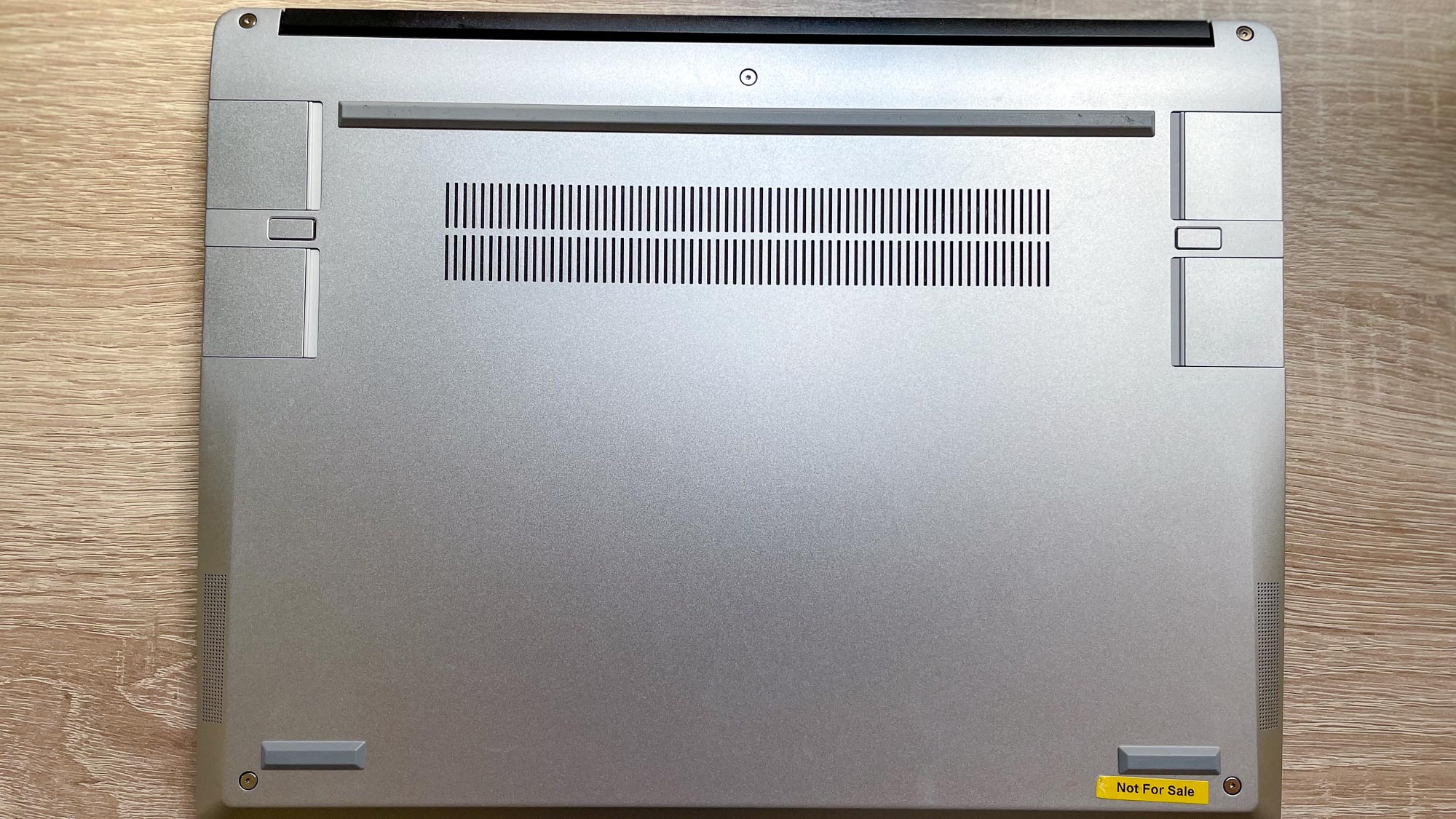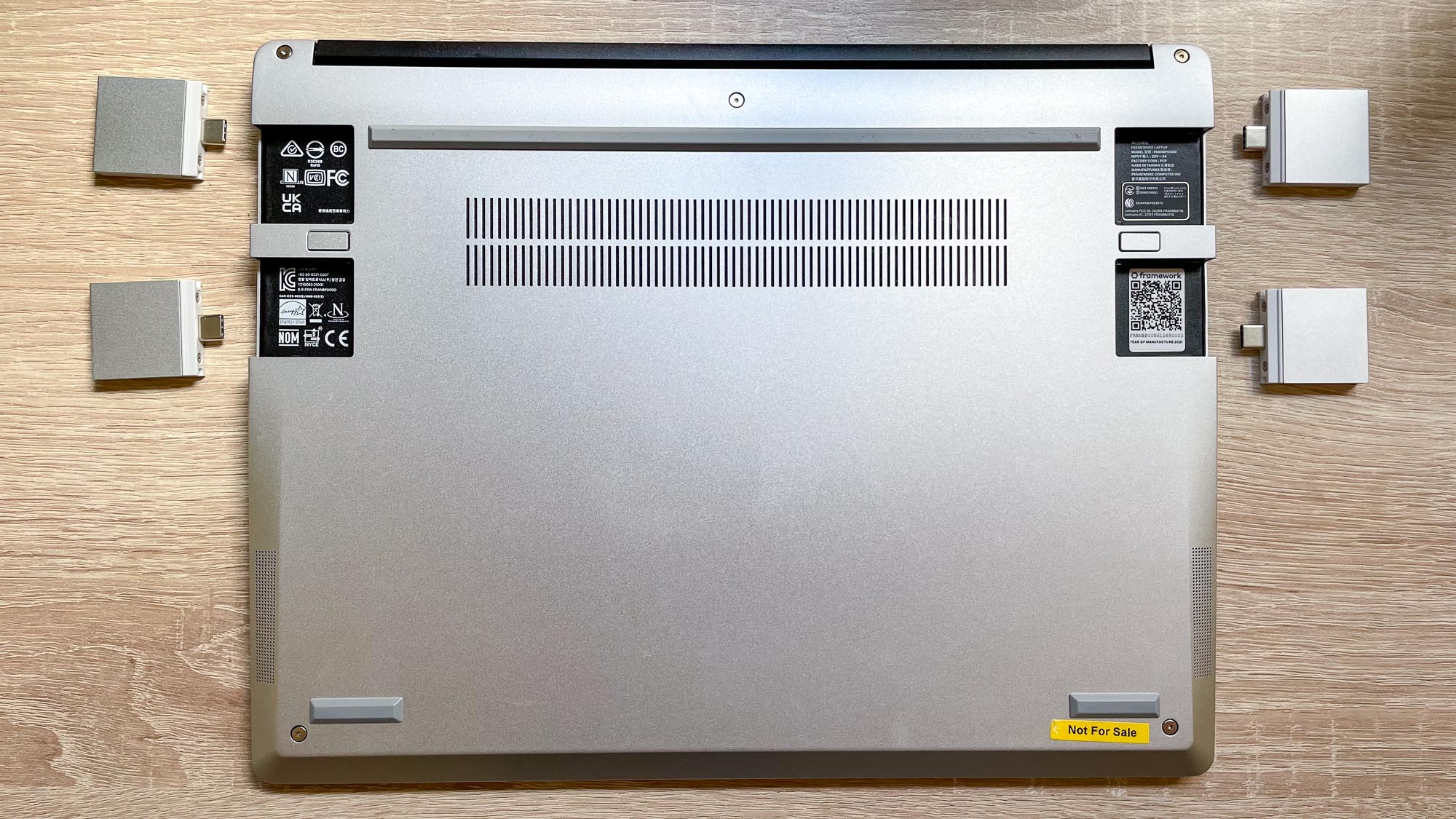Tom's Guide Verdict
The Framework Laptop is versatile, easy to carry, and well-made, all while providing owners unparalleled ease of access to upgrade and repair it.
Pros
- +
Slim and portable
- +
Tall 3:2 screen looks great
- +
Excellent keyboard
- +
Unprecedented access to modify and repair
Cons
- -
Unimpressive speakers with weak bass
- -
Fan is loud and unpredictable
Why you can trust Tom's Guide
Price: $1,399 as reviewed, $769 - $2,000+ based on config
Display: 13.5-inch 3:2 display (2,256 x 1,504 pixels)
CPU: Intel Core i7-1165G7
GPU: Intel Iris Xe integrated graphics
RAM: 16 GB
Storage: 512 GB NVMe SSD
Ports: 3.5mm audio jack, 4x configurable Expansion Cards
Size: 11.67 x 9 x 0.62 inches
Weight: 2.8 pounds
Editor's Note: Framework is making the world’s most exciting laptops right now in our computing editor's view, including a new 16-inch model coming out in mid-2023 and a revamped version of the 13-inch model reviewed here!
The Framework Laptop is one of the most exciting PCs to cross my desk in the past decade. This is the anti-MacBook, the laptop that promises to let you customize, repair, and upgrade it to an unprecedented degree, all while remaining affordable and ultraportable.
When Framework revealed the laptop in 2021, I was excited about those promises but dubious the company could deliver on them without some glaring sacrifices. Now that I’ve spent a few weeks reviewing one, I’m pleased to report that Framework appears to have stuck the landing.
The Framework Laptop ($749 to start, $1,399 as reviewed) we reviewed is versatile, well-made, and one of the best laptops you can buy — especially if you care about your right to repair and tinker with your devices.
Framework Laptop review: Price and configurations
- Priced between $1,000 - $2,000
- As cheap as $750 if you provide some components & assemble yourself
The Framework laptop is currently only available for purchase from the Framework website, and the price tag starts at $999 — though you can pay as low as $749 for the DIY Edition if you're willing to assemble your laptop yourself and provide your own memory, storage, operating system, and Wi-Fi card.
The base configuration of the Framework costs $999 pre-assembled and comes with an Intel Core i5-1135G7 CPU, 8GB DDR4 RAM, and a 256GB NVMe SSD with Windows 10 Home.

The performance configuration, which has a starting price of $1,399, gets you double the memory and storage (16GB DDR4 and a 512GB NVMe SSD) plus a Core i7-1165G7 CPU and copy of Windows 10 Home.
Get instant access to breaking news, the hottest reviews, great deals and helpful tips.
The top-of-the-line professional configuration starts at $1,999, and for that you're getting an even more powerful Core i7-1185G7 CPU, 32GB DDR4 RAM, a 1TB NVMe SSD, Wi-Fi 6 plus vPro for enterprise work, and a copy of Windows 10 Pro.
Due to the ongoing chip shortage, the company has had difficulty getting consistent supplies of one component. So it offered pre-orders in batches, and is now selling laptops in batches too: Each batch has its own ship date listed when you order, and as of publication all configurations are shipping about a month or two after you order them.
Framework Laptop review: Design
- As light and thin as a MacBook Air
- Yet somehow still fully user-accessible
- Each replaceable part labelled with a handy QR code
The Framework sports a slim, unassuming aluminum chassis that blends right in with all the other laptops in the coffee shop. Measuring in at 11.67 x 9 x 0.62 inches and just 2.8 pounds, this DIY ultraportable is as thin and just a hair lighter than Apple's MacBook Air with M1. That’s an even more impressive feat when you consider that the Framework team achieved that 0.62-inch thinness while still ensuring the major components of the laptop are modular and user-replaceable, rather than soldered to the board the way they are in the MacBook Air.

While the sleek and subtle design of the Framework chassis is easy on the eyes, the most exciting aspects are hidden away inside. To get there, you loosen five small screws on the bottom of the laptop. They’re common Torx T5 screws so you should have little trouble finding a screwdriver to fit them, and Framework also ships every laptop with a packed-in screwdriver/spudger that has a swappable T5/PH0 bit which fits every screw on the Framework.
Loosen the case screws and it becomes possible to lift the top of the keyboard deck (Framework calls it the Input Cover) away from the machine, exposing the neatly ordered guts within. This is the heart of the Framework’s promise: all the major components are clearly labeled and built to be swapped out, from the battery to the heat sink to the mainboard. It’s the most user-friendly approach to PC upgrades I’ve ever seen, as each swappable component is labeled with a QR code you can scan to get more information on the part and a guide on how to replace it. Framework is planning to tie even more functionality to these QR codes in the future, including links to purchase upgrades or resell parts on a future Framework Marketplace.

As long as you’re careful, futzing around with the Framework’s innards is pretty idiot-proof. I know because I’m an idiot.
I wish all PC component makers would include QR codes on their products, and I hope all laptop manufacturers will start treating their customers with the same respect Framework does. The accessibility of Framework’s laptop is such a refreshing change of pace from the way other laptop manufacturers do business: even if you never feel the urge to tinker with your laptop’s innards, just knowing that the Framework is designed to let you upgrade and repair it offers meaningful peace of mind.
And as long as you’re careful, futzing around with the Framework’s innards is pretty idiot-proof. I know because I’m an idiot, and even though it took me longer than I’d like to realize simple truths (including that the case screws are captive and not meant to come out so stop tugging on them, you fool) I managed not to break anything. The only real danger is damaging the ribbon cable which connects the touchpad to the motherboard, but that can be unplugged with relative ease.

The display is also replaceable, and the bezel around it pops right off so you can quickly swap it out for other color options. Our review unit arrived with only a black bezel, but the company has shown off a red variant and has plans to offer more for sale through the Framework Marketplace in the future.
Framework Laptop review: Display
The 13.5-inch display itself is sharp and functional, with a tall 3:2 display ratio that accommodates a 2,256 x 1,504 resolution. 3:2 displays on laptops have become more common in recent years, and I’m all for it — the extra vertical space helps you see more of a document or website at once, and that means less scrolling during day-to-day tasks.

It works well for entertainment too, as I discovered while watching my way through Amazon's The Tomorrow War and Making the Cut season two during this review. The Framework’s display has nice wide viewing angles, and it makes colors look crisp and vibrant, ensuring Tim Gunn’s salmon-shaded tie clearly stood out against his cerulean shirt.
In our testing, the Framework’s display achieved 112.5% of the sRGB spectrum, which means it's plenty colorful and close to the 100% sRGB ideal you might want if you’re going to be doing serious photo editing. And the screen gets pretty bright, achieving an average brightness of 418 nits and a peak brightness of 440 nits in our tests. That’s dimmer than the non-OLED Dell XPS 13 (469 nits) but brighter than competition like the M1-equipped MacBook Air (365 nits). This is important because dim laptop screens tend to look terrible in bright light, but in my experience the Framework gets plenty bright enough for comfortable use outdoors — though you’ll still be staring at your reflection quite a bit in direct sunlight.
Framework Laptop review: Ports
- 1 headphone jack + 4 user-configurable ports
- Choose-your-own port system offers unparalleled laptop customization
The port options on the Framework are wonderful because to a certain extent, they’re completely up to you. There's only one port on the Framework you can't change: The 3.5mm audio jack built into the left side of the laptop.

The rest of the laptop's ports are user-configurable thanks to the Framework's unique expansion card system. The bottom of the laptop sports four slots, each of which accepts a Framework Expansion Card that slides in with a click and connects to the laptop via USB-C. Swapping them out is as simple as holding the security catch which secures the cards and sliding one out, then sliding another one in. You can even hotswap ports while the laptop is running; Windows just reads it as swapping one USB device for another.

During the review I found this incredibly useful. For starters, you can put a USB-C port on either (or both) sides of the laptop to make plugging in the charger more convenient. Need to pull images off your DSLR? Swap in a microSD card reader for a few minutes, then swap it out for something more useful when you’re done.

Currently, Expansion Cards come in two flavors: storage (250 GB or 1 TB each) and ports (USB-A, USB-C, MicroSD, DisplayPort, and HDMI). The Framework ships with 4 USB-C cards by default, but you can mix and match to your heart’s desire. Just be aware they have different costs: the MicroSD card reader, DisplayPort, and HDMI cards are each $10 more than the USB cards, while the storage cards are currently $69 for 250 GB and $149 for 1 TB.
Framework says it has plans to release a broader variety of Expansion Cards (like say, headphone amps) in the future, as well as the goal of releasing the reference designs and specs for partner companies and the community to use in designing their own cards.
Framework Laptop review: Performance
- Powerful enough for work
- Not great for cutting-edge games
The Framework configuration we tested performed well under pressure, handling the gauntlet that is my unorganized work process (30+ open tabs in Chrome with multiple audio and video streams running simultaneously) without any noticeable stutter or heat issues. However, the laptop’s cooling fans occasionally kicked in during daily use, and they’re awfully loud.
When we put the Framework to the test using the GeekBench 5.4 multicore CPU benchmarking tool, the modular laptop with its Intel Core i7-1165G7 CPU earned a respectable score of 4,423. That’s good enough for most day-to-day work, but it pales in comparison to scores earned by the Core i7-equipped Dell XPS 13 (5,524) or the AMD Ryzen 7-equipped Asus ZenBook 13 OLED (6,411).
To get a sense of how quickly the Framework’s SSD can move data around we also tasked it with copying thousands of multimedia files — 25 GB in total — and measured how fast it completed the task. The Framework achieved a peak transfer speed of 787.32 MBps, a great score that tops those earned by the Dell XPS 13 (742 MBps) and the Microsoft Surface Laptop 4 (562 MBps) in the same test. However, it’s not quite as speedy as the Asus Zenbook 13 OLED (873 MBps) or the Samsung Galaxy Book Pro 360 (869 MBps).
The Framework probably won’t be your ideal choice for editing video, but it can handle the work in a pinch. When we asked the Framework to transcode a 4K video down to 1080p via Handbrake, it completed the task in an average of 13 minutes and 9 seconds. That’s pretty good, and it’s faster than the Dell XPS 13 (18:12), the 13-inch Surface Laptop 4 (17:01) or the Samsung Galaxy Book Pro 360 (16:24). However, it’s still a few minutes slower than the AMD-powered Asus Zenbook 13 OLED (8:22).

While the Framework's lack of a discrete GPU makes it a poor choice for playing graphically demanding games, the Core i7 CPU gives it enough muscle to play older and less demanding games well. I had a lot of fun noodling around in games like Crusader Kings III and Othercide on the Framework, but don't expect to run Cyberpunk 2077 on this thing.
Framework Laptop review: Audio
- Speakers can get loud
- Bass sounds muted
The speakers on the Framework can get loud enough to cause real problems with your neighbors, as I discovered first-hand during testing. They should be plenty loud enough for your needs, and the quality of sound they kick out is pretty good.
The bass is pretty muted compared to some other laptops (I’m thinking specifically of the Microsoft Surface Laptop 4), but vocals like those on Bill Withers’ “Lovely Day” sound clear and warm.
Framework Laptop review: Keyboard and touchpad
- Keyboard feels great to type on
- Fingerprint reader in the power button is a nice touch
I’ve typed on a good number of laptop keyboards this year, and the Framework is easily my favorite. My big hands rest comfortably on the deck, each key is large enough — and more importantly, has enough space around it — that I rarely hit another key by mistake, and the 1.5mm of key travel is enough to make every key press feel satisfying and distinct. The fingerprint reader built into the power button is also a nice touch.
The touchpad beneath the keyboard is also easy to reach and comfortable to use. In my experience, the best touchpads are the ones you don’t have much to say about, because they just work. The Framework has just such a touchpad, and in my experience it’s reliable and works well. I had no issues using it throughout my workday, whether I was using Windows gesture controls to swap between apps or tapping and swiping through some after-hours web browsing.
Framework Laptop review: Webcam
- 1080p webcam delivers good image quality
- Separate switches for physically disabling webcam/microphone
The 1080p webcam built into the top lip of the Framework’s display is a welcome change from the grainy 720p cameras so many modern laptops still sport. It captures vibrant images, and during Zoom calls the video quality is clear and smooth. There's no IR camera for facial authentication via Windows Hello, but you can use the fingerprint reader on the keyboard for biometric authentication.

The physical privacy shutter built into the camera is a nice touch. The webcam is flanked by a pair of small plastic switches: the one on the left cuts power to the microphone, the one on the right cuts power to the camera. It’s a level of respect for user privacy that I wish all laptop manufacturers would show their customers, even if I think most of us will never have cause to care.
Framework Laptop review: Heat
- Laptop gets warm but not hot
- Loud fan sometimes kicks on during daily use
The Framework can get warm enough to keep your lap toasty, but in the course of testing it never became uncomfortable, even when playing games. When we used our infrared heat gun to take the laptop’s temperature after it spent 15 minutes under heavy load, we found the hottest point (topping out at 98.4 degrees) is on the center of the underside, near the hinge.
However, I did notice some serious fan noise coming out of the laptop. Not always during heavy use, either; to the contrary, a few times I was standing across the room doing something else entirely when suddenly I’d hear the Framework’s fans kick on. I haven’t been able to isolate why this occasionally happened with our review unit, and it doesn’t impact performance or use in any way, but it is surprisingly loud.
Framework Laptop review: Battery life
- 10+ hours of battery life
- Battery charges quickly
The Framework’s battery doesn’t break any records, but it’s good enough to get you through a day of work without needing to pack a charger. In our battery test, which sets the laptop’s screen brightness to 150 nits and tasks it with endlessly browsing the web via Wi-Fi, the Framework lasted 10 hours and 17 minutes. That’s better than the Dell XPS 13 (7:59), though not nearly as long-lived as the Samsung Galaxy Book Pro 360 (13:33) or the Asus Zenbook 13 OLED (15:00). And of course, it still can’t come close to matching the MacBook Pro with M1’s remarkable 16-hour battery life.
Still, 10+ hours on a single charge is nothing to sneeze at. The Framework charges quickly, too; I plugged it in at 5% power, and about an hour later the battery was up to 74% power.
Framework Laptop review: Verdict
There's a lot to love about Framework's inaugural laptop. Working on it is downright comfortable thanks to the nice tall screen and spacious, satisfying keyboard. It's thin and light enough to throw in a bag for all-day carry, and the 10-hour battery life should let you get away with not packing a charger. Plus, the swappable card system lets you reconfigure it on the fly with whatever ports you'll need for the day.
But the real selling point is how wonderfully accessible and repairable the Framework Laptop is, and the value of that will vary greatly depending on how excited you are to crack one open. For those of us who prize having easy access to our devices, the Framework is the best example yet that laptops can be powerful, portable, user-accessible, and still sold for a competitive price. It's a real achievement, one I'd like to see other laptop manufacturers copy.
But if you'd rather not worry about swapping out pieces of your laptop, there are other devices on the market which deliver better performance than the Framework for less. The Asus Zenbook 13 OLED, for example, is an excellent ultraportable that tops out at around $1k and offers a gorgeous OLED screen, great performance, and fantastic battery life.
And of course, a big part of the Framework Laptop's value is tied up in how well the company supports the community post-launch. Framework has admirable plans to continue releasing new expansion cards and components, as well as reference designs and specs so both partner companies and the community at large can build their own accessories and sell them on the Framework Marketplace.
If that all pans out, owning a Framework Laptop could grant you access to a community of fans and vendors for years to come. But if Framework can't follow through on its promises, Framework owners might end up on their own.
Next: Read about how my colleague built a Framework laptop himself and it lived up to the hype.

Alex Wawro is a lifelong tech and games enthusiast with more than a decade of experience covering both for outlets like Game Developer, Black Hat, and PC World magazine. A lifelong PC builder, he currently serves as a senior editor at Tom's Guide covering all things computing, from laptops and desktops to keyboards and mice.

